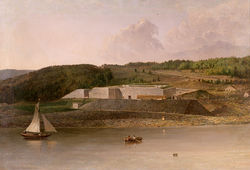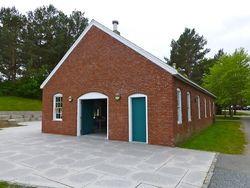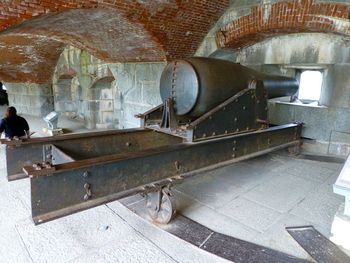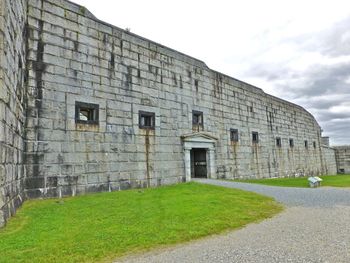Fort Knox (1)
|
Fort Knox (1) (1844-1923) - A Third System Fort designed by Chief Engineer Joseph G. Totten and constructed between 1844-1869 under the supervision of Bvt. Major Isaac Ingalls Stevens (1848), Captain Thomas L. Casey (1861-1866) and others. Named for Major General Henry Knox, first U.S. Secretary of War. Assigned Location ID ME00059.
Third System (1816-1867)  Established to protect the Penobscot River valley from attack. Fort Knox was designed as a two-level granite Third System Fort containing mounts for 64 cannons. Four external batteries, mounting a total of 69 cannons, cover four lines of defense outside the main building. Fort Knox was built as a pentagon with two long walls along the riverside, two short walls on the right and left flanks and a single long wall along the back. The two long walls on the riverside contained a single tier of casemates for river facing cannons. The terreplein on top of all five sides had emplacements for 30 additional cannons. The three land side walls were surrounded by a constructed ditch which was in turn surrounded by two walls and a Glacis in back, all to protect the fort from landside attack. Additional cannons were mounted in Battery D on the north outer wall. Fort Knox was planned to hold a total of 135 cannons. At the center of the two riverside walls was a bastion to protect the walls from land assault. At both ends of these walls was a demi-bastion for further land assault protection. The bastion and demi-bastion were designed for flank howitzers that could fire along the outer wall to prevent anyone from scaling the walls. Inside the fort, the back wall contained living quarters and mess facilities in a unique stepped barracks arrangement. The short side walls contained officer quarters and magazines. Between the end walls and the casemate walls were two circular staircases that led from the parade up to both levels of the casemates Two major external gun batteries were constructed in front and below the stone fort in the 1840s to provide an interim defense while fort construction continued. The batteries were designated Battery "A" and Battery "B" and were first completed in the 1840s but not armed. These batteries were designed for the armament of the day like the 32-pounder smoothbore cannon.
U.S. Civil War (1861-1865) At the beginning of the U.S. Civil War the fort was still not nearly complete and Battery A and Battery B still had no cannons. When then Captain Thomas L. Casey took charge of construction in August 1862 the fort still had no cannons and it was clear that the armament that the fort was designed for was no longer adequate. Batteries A and B had been designed for cannons like the smoothbore 32-pounder that would be hopelessly outgunned by newer guns. Both Battery A and Battery B were rebuilt for the newer 10" and 15" Rodman cannons and that work was complete about 1863. The first 10 Rodman cannons arrived in July 1863 and were split between Battery A and Battery B, Battery A received eight of the 10" Rodmans and Battery B received two 10" Rodmans. Sixty-four more cannons were delivered before the decision was made to stop arming Fort Knox. Batteries A and B were again modified to hold three 15" Rodman cannons in 1865-1867. Two of the 15" Rodmans were planned for Battery A and one for Battery B. 1870 era photographs show battery A fully armed including the two 15" Rodmen and thirty-two 10" Rodmans. The upper level of the main fort, the terreplein, was built to mount thirty cannons and was complete in September 1864 but it was never armed. The casemates below the terreplein were meant to protect another 23 larger cannons. At least fourteen 10" Rodman cannons were mounted in the casemates. Work stopped in 1869 and the fort was still not completely finished.
Current Status One of the best-preserved coastal fortifications in New England. Mounted cannons on display inside and out. A magazine has been restored and is open to visitors inside the old fort. The 1900 mine storage building has been converted into a visitor center and museum. Exceptional interpretive signs and displays throughout the park. This is a must-see fort.
Sources:
Links: Visited: 16 Jun 2012
| ||||||||||




















